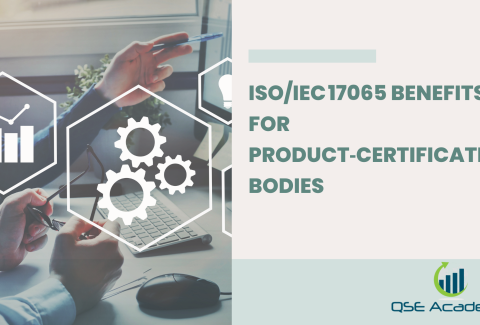ISO/IEC 17065 Glossary: Plain‑English Terms
Making ISO/IEC 17065 Easy to Understand
If you’ve ever opened ISO/IEC 17065 and felt overwhelmed by the terminology, you’re not alone.
Even experienced certification managers sometimes stop mid-sentence and ask, “Wait—what’s the difference between evaluation and review again?”
In my experience, clarity with terms makes or breaks an implementation. When everyone in your team speaks the same “ISO language,” your documentation flows better, your audits run smoother, and misunderstandings disappear.
This glossary translates ISO/IEC 17065’s technical language into plain English—so you can understand, teach, and apply it with confidence.
Why Plain-English Definitions Matter
ISO/IEC 17065 can feel dense, but the goal is simple: trust through consistency.
That trust starts with understanding what every term actually means.
When terms like certification decision or scheme owner are misused, it leads to real-world consequences—like audit findings, miscommunication with clients, or duplicated effort in documentation.
Example:
A certification body I worked with kept mixing up “evaluation” and “audit.” Once they rewrote their procedures with clearer, plain-English definitions, they cut their nonconformities by half at their next accreditation assessment.
Pro Tip:
Use this glossary in your internal training sessions. Accreditation bodies appreciate when your staff use consistent, simple language—it shows competence and control.
 Core Terms Every Certification Body Should Know
Core Terms Every Certification Body Should Know
Here are the foundational terms you’ll see throughout ISO/IEC 17065—explained simply and grouped for quick reference.
A. Accreditation & Certification Basics
Accreditation
Formal recognition that your certification body operates competently and impartially. It’s granted by an accreditation body—not your clients.
Certification
Official confirmation that a product, process, or service meets specific requirements.
Conformity Assessment
The overall process of checking if something meets requirements. It includes testing, inspection, and certification.
B. Key Players in ISO/IEC 17065
Certification Body (CB)
Your organization—the one performing product, process, or service certification.
Scheme Owner
The organization or entity that develops and maintains the certification rules. For example, a national organic certification program or eco-label authority.
Applicant / Client
The organization seeking certification.
Technical Expert
A specialist who provides specific technical input during evaluation. They don’t make the final certification decision.
Decision Maker
The person (or committee) who approves, maintains, or withdraws certification after reviewing all evaluation results.
C. Process & Evaluation Terms
Application Review
Your initial check to make sure the client’s request fits your certification scope.
Evaluation
The process of examining test results, inspection reports, or documentation to verify compliance.
Review
An independent check to confirm that evaluation results support the certification decision.
Certification Decision
The final, formal judgment—grant, maintain, suspend, or withdraw certification.
D. Integrity & Quality Terms
Impartiality
Freedom from bias or conflict of interest. Your decisions can’t be influenced by personal, financial, or organizational pressure.
Confidentiality
Keeping client and product information secure and private.
Competence
Having the skills, knowledge, and experience to perform a task effectively.
Appeal
A client’s request to reconsider a certification decision (for example, if their application was denied).
Complaint
Any expression of dissatisfaction about your certification services—filed by a client or external party.
E. System & Documentation Terms
Management System
Your internal structure of policies, procedures, and controls that ensures certification activities run consistently.
Scheme Document
The rulebook for your certification process—it defines scope, criteria, testing methods, and surveillance rules.
Surveillance
Ongoing monitoring after certification to confirm continued compliance.
Mark of Conformity
The label, logo, or symbol showing a product or service has been certified. (Think of organic or CE marks.)
Commonly Confused Terms Explained
Some terms sound similar but mean very different things. Let’s clear them up:
Evaluation vs. Audit
An evaluation checks compliance through testing, inspection, or review of evidence.
An audit assesses management systems and processes—used mainly in ISO/IEC 17021-1.
Certification Body vs. Inspection Body
A certification body issues certificates confirming compliance.
An inspection body performs evaluations but doesn’t issue certificates of conformity.
Scheme Owner vs. Accreditation Body
The scheme owner creates and manages certification rules.
The accreditation body assesses whether your certification body meets ISO/IEC 17065 requirements.
Pro Tip:
When writing your Quality Manual or procedures, make sure you use ISO-consistent definitions. Accreditation assessors often check this alignment first.
How to Use This Glossary in Your Certification System
Don’t let this glossary sit in a folder—make it part of your daily operations.
Here’s how to use it effectively:
- Include it in new-staff orientation and auditor training.
- Reference it in your Quality Manual so everyone uses consistent language.
- Update it during management reviews—especially if you add new certification schemes or product types.
Example:
A certification body I supported added this glossary to their auditor handbook. Within months, they noticed better consistency in audit reports and smoother assessor communication.
FAQs
Q1: Are ISO/IEC 17065 definitions legally binding?
Not exactly, but they follow international terminology (ISO/IEC 17000 series). Using them consistently keeps your system aligned with global standards.
Q2: Can we rewrite definitions for internal use?
Yes—simplify them for your team. Just keep the original meaning intact to avoid misinterpretation during audits.
Q3: Where can we find official definitions?
Check ISO/IEC 17065, ISO/IEC 17000, and IAF/ILAC guidance documents for the authoritative language.
Conclusion: Clarity Builds Confidence
Once your team speaks the same ISO/IEC 17065 language, everything gets easier—writing procedures, training auditors, and preparing for accreditation.
Clarity eliminates guesswork and strengthens credibility with both clients and accreditation bodies.
If you’d like a ready-to-use reference, download QSE Academy’s “ISO 17065 Plain-English Glossary PDF.”
It’s a simple tool to help your team master the language of product certification—without the jargon.
Melissa Lavaro is a seasoned ISO consultant and an enthusiastic advocate for quality management standards. With a rich experience in conducting audits and providing consultancy services, Melissa specializes in helping organizations implement and adapt to ISO standards. Her passion for quality management is evident in her hands-on approach and deep understanding of the regulatory frameworks. Melissa’s expertise and energetic commitment make her a sought-after consultant, dedicated to elevating organizational compliance and performance through practical, insightful guidance.









